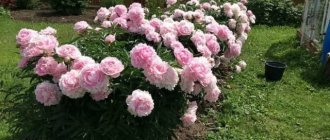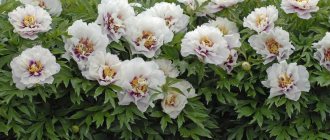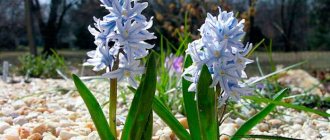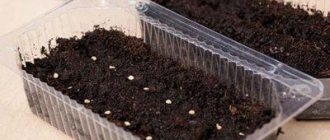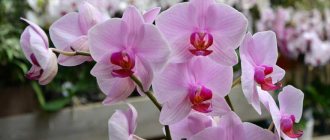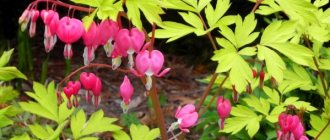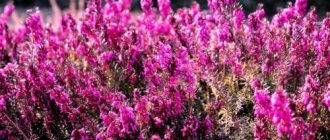Peony thin-leaved (Paeonia tenuifolia) - what kind of plant?
This rare flower in domestic gardens deserves close attention and wide distribution.
Brief description and characteristics:
- Perennial.
- The height of the bush is 40-50 cm.
- One-time flowering.
- Flower diameter is up to 7-9 cm.
In natural habitat
- The color of the outer petals is bright red, crimson, dark cherry with a satin tint. The anthers are yellow, the filaments are purple. The wild species has 10-12 petals arranged in one to three rows; a terry form (Rubra Plena) is found.
- The smell is subtle and pleasant.
- Flowering is very early (late May-first half of June).
- Frost-resistant, can grow in climate zones 2-8 (down to minus 45 degrees).
Other names
In different regions and among local residents, other names for this plant are found:
- narrow-leaved peony,
- holly peony,
- fern-leaved peony,
- Voronets peony,
Peony fruits
- Voronets,
- Funnel (according to the color of the seeds),
- Zelenika,
- Red Blue Lizzie,
- azure flower,
- Fringed peony.
Advantages and disadvantages of the type
The species is distinguished by very bright flowers and decorative foliage. It blooms at the same time as tulips, and after flowering it remains decorative. It is unpretentious and almost never gets sick. Greenery can be used to decorate bouquets. It grows in one place for up to 15 years.
Poisonous, attracts ants and aphids. Loses its attractiveness in the second half of summer. It blooms only in 4-5 years.
Use in landscape design
The species is used both in monoculture beds and as part of large rock gardens, among stones, against the backdrop of scree, and in mixborders. Interesting for creating steppe areas, where it can be combined with cereals, flax, saxifrage and wormwood.
Attention! Thin-leaved peony is very interesting for breeders for developing new varieties.
Varieties that are very popular with gardeners
Peony Pink Hawaiian Coral - cultivation and care
Due to its exotic nature, there are few varieties of peony of this species, but in addition to the official ones, breeders can find different forms of the wild plant, differing in flowers and leaves from each other.
- Eaglet
Dark red flowers with 6-9 petals in one row and dissected small foliage, pleasant scent. The height of the bush is up to 0.6 m.
- Tiny Tim
A very early variety with semi-double flowers, a bush of regular shape.
- Rubra Plena
Terry peony, a small-leaved variety, is one of the most decorative and sought-after.
Terry variety Rebra Plena
- Early Scout
Dark green small leaves, cherry blossoms.
- Merry Mayshine
A simple flower with a diameter of 13 cm, dark red with golden stamens, petals more than 6 cm wide. Erect strong stems, dark green durable foliage. Good for cutting. The aroma is weak.
- Terry thin-leaved
Basically, this description applies to Rubra Plena, but double and semi-double forms are also found in the narrow-leaved field peony.
- Other
There are descriptions of yellow, pink and white inflorescences, semi-double and double forms of thin-leaved peony. The dwarf Little Rhyme, tall bright pink Rose Garland, dark cherry with almost black buds Chocolate Soldier and many others deserve the attention of gardeners.
Growing a flower, how to plant it correctly in open ground
The species is propagated by seeds, dividing the bush or root cuttings, stem cuttings, layering.
Planting with root cuttings
Paeonia Festiva Maxima
The peony division must have at least 2-3 buds on the root collar, and the root length must be at least 15 cm.
Small rhizomes with 1–2 buds, if they have at least one root, can also be planted. They are quite viable and take root well with a slight delay in the development of the bush.
What time does boarding take place?
Replanting, planting and dividing the peony bush is done from mid-August to mid-September. At this time, the growth of overgrown small roots occurs, due to which the bush is nourished.
Partial rooting of plantings, which continues intensively immediately after the soil thaws in the spring, contributes to a faster start of peony flowering. At other times, it is necessary to ensure the safety of not only the roots, but also the shoots.
Selecting a location
Peonies reach their maximum development at 4–5 years and, with good agricultural technology, bloom profusely for another 8–12 years. The plant loves bright places and reacts to strong darkening by reducing the abundance of flowering and having paler flowers. The location is selected taking into account the absence of roots of shrubs, trees and nearby groundwater.
The ideal place is well-lit, with daytime openwork partial shade, away from buildings and large trees, protected from the wind.
Important! Water stagnation and high groundwater levels are unacceptable!
How to prepare the soil for planting
Fleshy perennial roots of peonies with a large supply of nutrients for normal plant development require fertile, well-cultivated soils and planting sites with a cultivation depth and diameter comparable to the size of the bush and its root system.
The groundwater level should be no higher than 1 meter. The peculiarity of the angustifolia peony is that rocky, moderately humid and slightly dry places are acceptable.
Growing peonies requires well-drained soil with good water and air permeability. Drainage made of bricks, stones is laid at the bottom of the seats, and rusty iron can be added.
On heavy clay soils, sand is added to the pit; on sandy loam and sandy soils, clay is added. Rotted manure or compost is added to the mixture, per hole, depending on the volume, 100-200 grams of superphosphate, 100-150 grams of potassium sulfate and dolomite flour, lime or ash in acidic soil. It is better to clarify the dosage of fertilizer in the instructions. The soil is compacted a little.
The upper part of the hole (15-25 cm) is filled with ordinary fertile soil without fertilizers, and the plant is planted in this layer.
For reference! The recommended soil acidity is slightly acidic (pH 5.5–6.5).
Preparing a seedling for planting
The delenka is inspected, damaged and rotten roots are removed, sections and broken parts of the root are powdered with ash, charcoal, and a growth stimulating agent. Large roots are cut to 1/3 of their length.
Important! The seedlings should be handled carefully; the roots break easily.
Peony planting procedure step by step:
- Choose a location.
- Prepare the planting hole by arranging a drainage layer, fill it with soil and fertilizers. Make a hole.
- Prepare peony seedlings (cuttings, young bush).
- Set the level, marking it with a stretched rope or board
- Place the seedling in the prepared hole, checking the depth of the buds. Large roots are placed in a hole without bending to avoid their fracture. The growth points of the seedling should be at a depth of 3-4 cm. After the soil settles, the seedling settles by 1.5–2 centimeters.
- Fill the hole with fertile soil.
- Use your hands to gently squeeze the soil, compacting it around the roots.
- Sprinkle generously with water at the rate of 1-2 buckets per plant. If necessary, add more soil if it subsides.
- Mulch with compost, straw, peat, and chopped bark.
- When planting late, provide shelter for the seedling.
Delenka seedling
Planting with seeds (for selection)
Peony Felix Krauss (Paeonia Felix Crousse - planting and care
The peony fruit is a star-shaped multi-leaflet, each of which contains several large shiny seeds of black or brown color, from which the species got its name “Voronets”.
The time to collect planting material is when the fruit bursts and the not yet dark seeds are visible through the half-opened doors. If you plan to grow seeds in the garden, you need to take them out of the boxes, mulch them with wet sand, bark, light soil and put them in the refrigerator before planting, remembering to constantly monitor the moisture content of the sand.
In open ground, it is enough to sow the seeds in a prepared place in shallow grooves. Sprouts appear in the second year.
For faster germination of peony seeds, three periods are needed - warm-cold-warm.
- In the first warm period, sprinkle the seeds with sand and water with warm water. Place in a mini-greenhouse. It is necessary to maintain the temperature from +16 to +25 degrees, ventilate and moisten the sand until roots 1-2 cm long appear.
- In the cold phase, plants that have developed roots should be planted in peat soil. The temperature should be +6..+10 degrees. Monitor humidity (it should be about 10%) and the absence of sudden temperature changes. The cold phase lasts 3-4 months, daily ventilation is necessary.
- In the second warm phase, growing peony sprouts is no different from growing other plants.
How is peony used in folk medicine?
In folk medicine, funnels are in much greater demand than in pharmacology. Healers make tinctures and decoctions from the roots, flowers, leaves, and petals of peony, focusing exclusively on the medicinal properties of the plant and often neglecting contraindications.
An ointment made from funnel is effective in eliminating the consequences of fractures, can heal bones, and is used in the treatment of trigeminal and sciatic neuralgia.
The ointment is made exclusively from the roots of the plant. To do this, they need to be washed well, dried and grated. Mix the ground root with pork internal fat (1:1) and leave for 30 minutes in a water bath in a closed container.
Article on the topic: Zherukha officinalis - beneficial properties, description
A decoction of medicinal peony is effective in the treatment of epilepsy, seizures, spasms, and rapid heartbeat. It is also used for insufficient urination and in the fight against gout.
To prepare the decoction you will need dried funnel root, about 20-40 g. The substance is poured with a liter of water, boiled and filtered. You need to take this medicine 3 times a day, half a glass.
But we must not forget that peony root has both medicinal properties and contraindications. Therefore, self-medication can have harmful consequences. It is worth starting with an excellent study of the characteristics of your body and treating it only under strict medical supervision.
Lazorika infusion is most often used in the treatment of heart diseases. It is made from root cones. One teaspoon of crushed roots must be poured into 400 ml of boiling water and allowed to boil for 5 minutes. After this, strain and take half a glass 3 times a day.
In addition, you can also prepare an infusion from the herbaceous part of the plant. For this you need 1 tsp. dilute raw materials in 3 cups of boiling water, leave for 30 minutes, strain and take 1 tbsp. l. 5-10 minutes before meals.
The prepared product improves appetite and improves the digestive process. These medications should be taken with extreme caution.
Peony tincture is best purchased at a pharmacy. If desired, you can make it yourself. But do not forget that such an activity requires special care and responsibility.
Ingredients for tincture:
- 20 g crushed leaves, roots, stems, funnel flowers;
- 200 ml vodka.
These components must be mixed in a dark container. Close the container and place in a cool, dark place for 2 weeks. After expiration, strain off the finished tincture. It is recommended to take the drug 3 times a day, 15-20 drops 10-15 minutes before meals for 2 weeks.
To prevent colds and strengthen the immune system, you can drink tea with peony. To prepare it, you only need the ground part of the funnel. Brewing tea is not difficult. You just need to fill the raw material with hot water and boil.
Plant care
The species is unpretentious, the plants will grow almost without care. But following simple rules will allow them to be more magnificent, bloom earlier and more abundantly.
Young plant
Watering and fertilizing
In the first two to three years after planting, fertilizing is not needed; the plants receive a sufficient amount of nutrition from the planting mixture.
Young plants actively consume moisture at the end of June - July, when growth buds are formed and formed. It is better to water the plants only at the roots.
The frequency of watering in the absence of rain is once a week, the consumption per plant is 10–15 liters of water. If desired, watering continues until the end of August. Voronets is a species with a pronounced period of summer dormancy, so if there is a lack of moisture, the bush will quickly lose its color after flowering.
In subsequent years, the plants are fed with organic and mineral fertilizers immediately after the plants awaken. After fertilizing, plants are watered abundantly; when dry, the soil is loosened and mulched.
Important! The composition of fertilizers should be dominated by potassium and phosphorus; an excess of nitrogen can negatively affect flowering, lead to fungal diseases and lodging of shoots.
Mulching and loosening
Peony develops well in light, loose soils, so after watering you need to loosen the soil around the bush. The ground can also be mulched with straw, hay, chopped bark, or you can use cut paper or cardboard.
Reproduction methods
Reproduction is carried out by dividing roots or planting seeds. The seed method is more complicated and is suitable only for experienced gardeners, but it allows you to obtain more planting material. Seeds are taken unripe and sown in a flowerbed in the fall; until this time they can be stored in a cool place (refrigerator, cellar). Young shoots need to be cared for in the same way as an adult plant; they require watering and loosening of the soil.
Most often, propagation is carried out by dividing the roots. Adult (at least 5 years old) well-grown bushes are suitable for this; they are divided into several parts and planted in different places. Each root should have 2-3 live buds. If the soil is selected correctly, the bushes do not require fertilizing for the first two years.
Period of activity and rest
The peony growing season is from May to October. The presence of powerful rhizomes with food reserves allows the species to be used for forcing, but in this case it is necessary to provide a large space for the bush and active supplementary lighting.
Peonies in flowering period
The peony blooms in mid-May - early June, after which the color of the foliage deteriorates, the plant goes into summer dormancy, but with continued watering the bush retains its beauty.
Care during and after flowering
It is not recommended to cut off all flowering shoots, as this will greatly weaken the peony, and it will bloom much weaker next summer. After flowering, you can remove the inflorescences along with part of the stem. It is not recommended to remove the entire stem.
If you cut too many stems, they will have time to grow back and even throw out buds.
Interesting! If the peony is not watered after flowering, the plant goes into hibernation, the leaves fall off, and the shoots dry out. This state of rest is quite normal.
Peony does not bloom - possible reasons, what to do
The main problems due to which peony does not bloom:
- the seedling is planted too deep;
- the buds are frozen due to a harsh winter or insufficient shelter for the plant;
- the seedling is weak, planted in poor condition or transplanted several times;
- the bush is old - in this case it is necessary to divide the bush;
- bad place, full shade or bush is flooded with water;
- the plant is sick or damaged by pests.
Useful properties of the plant
Voronets is considered a poisonous plant, but has beneficial properties; it is used for the production of medicinal substances. To prepare them, roots , buds or leaves are used.
The pomace is used to produce analgesics and antispasmodics that help with:
- cold;
- anemia;
- kidney diseases;
- lung diseases;
- of cardio-vascular system.
The plant contains tannins , vitamin C and healthy oils.
If Voronets is used to create tinctures at home, you need to be very careful not to exceed the dosage of the substances.
Transplanting an adult bush
It is advisable not to replant a healthy bush without visible problems at all. But if this is necessary, the bush is replanted in the spring or in August-September with a lump of earth or the replanting is combined with dividing and propagating the bush.
For replanting that does not injure the plant, a circular ditch of as large a diameter as possible is dug (at least 10-15 centimeters from the crown projection), the bush is carefully lifted from several sides using shovels, or a sheet of metal (a snow shovel is suitable) is placed under it using a dig and a circular ditch. in which the plant is transported to a new location. Planting is carried out according to the same rules as a regular seedling.
Harm and contraindications
Voronets is a toxic plant. Even the slightest deviation from the doctor's recommendations and dosages can cause harm to your body.
It should be remembered that folk remedies from peony are contraindicated for the following categories of people:
- those suffering from high stomach acidity, pancreatitis;
- patients with hypotension;
- people with liver and kidney disease;
- For pregnant and breastfeeding women, Voronets medicines are strictly prohibited;
- alcohol dependent;
Taking funds from the funnel can cause a number of side effects, including excessive drowsiness, exhaustion, attacks of vomiting and nausea, abdominal discomfort, a sharp drop in blood pressure, and allergic reactions.
Such an inconspicuous and rare flower, as you can see, is a source of many useful substances that are in great demand among doctors and healers. But only a properly organized treatment process can be beneficial, otherwise you will only harm yourself.
Diseases, pests and ways to combat them
Wild peony of this species is almost not affected by diseases and pests. But some owners report the following problems:
- Rust. Spots appear on leaves and shoots. They need to be collected and burned, the plant should be sprayed with 1% Bordeaux mixture.
- Because they are attractive to ants, they are susceptible to attack by aphids. In this case, insecticides are used.
- In May, shoots and buds can be damaged by the cockchafer and recurrent frosts.
This type of peony is decorative, unpretentious and can decorate the collection of a professional breeder and the flower garden of a novice gardener. Once popular, forgotten and now back in nurseries, this plant with exquisite flowers and unusual foliage deserves close attention.
Useful properties and uses of Voronets
There are not many flower growers and healers who know the true value of angustifolia peony. And the population of the plant itself is rapidly declining.
Today, wild peony is better known as a flower listed in the Red Book. The reason for this phenomenon is paradoxical: somewhere in the 70-80s, large-flowered peonies replaced the medicinal peony from gardens and vegetable gardens.
Nevertheless, funnel is a powerful healer with high pharmacological properties and is popular in medicine and herbal medicine. Let's consider what its healing power is.
